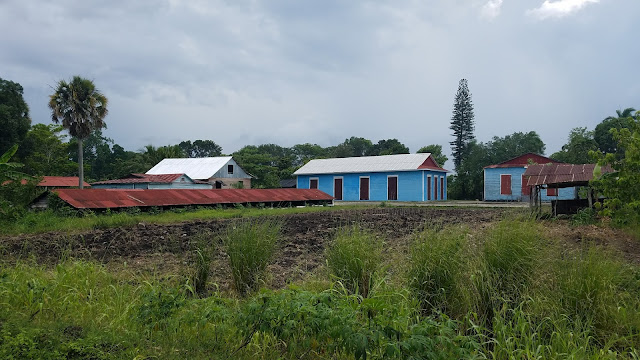Strengthening agroforestry systems in smallholder Dominican farms
Altair Rodriguez’s demonstration farm in La Vega Province, Dominican Republic
In August 2017, Farmer-to-Farmer
(F2F) volunteer Tom Gaman traveled to the Dominican Republic to support the
agroforestry efforts of Altair Rodriguez’s demonstration farm.
Located in La Vega Province, Finca Tierra Negra is a 66 hectare farm
that is made up by partially-shaded cacao trees grown primarily under a broken
canopy of nitrogen-fixing native (e.g.Erythrina) and non-native trees (e.g.
African Tulip). Much of farm sits on land that was previously used to produce conventional
plantain (Musa paradisiaca) and
cassava (Manihot esculenta).
The land
is also susceptible to excess concentrations of pesticides and inorganic
fertilizer runoff emanating from nearby farms. There are also a series of
non-organic crops in the farm that have been neglected for years, and are hampering
the ability of the Rodriguez family from obtaining organic production. Altair and
her family are currently trying to integrate more organic agro-forestry systems
at Finca Tierra Negra. With these
systems in place, they hope to restore and improve soil quality, increase
production, and generate a higher and more diversified income base for the
family and the surrounding community that benefits from the demonstration plots.
With these challenges in mind,
the purpose of Tom Gaman’s assignment was to help the farm complement the farm’s
existing base of cocoa trees, permaculture systems, and nursery with more
robust agroforestry systems. As part of these efforts, Tom carried out an
extensive forest inventory of the demonstration farm, which included using
Geographic Information Systems (GIS) in order to inform the long-term agroforestry
implementation and monitoring plan for the property. Based on his field observations,
Tom and Altair discussed ways to put in place a diverse set of
financially-viable climate-smart crops, such as breadfruit and locally-appropriate
spices (e.g. turmeric). Prior to ending his assignment, Tom also generated a
series of practical recommendations that Altair and her family can use to incorporate
new agroforestry systems into their farm.
These recommendations included:
- The use the GIS tools and agroforest inventory plots established during the assignment to inform on-site management decisions (e.g. planting locations & species combinations)
- Based on GIS maps and inventory, continue to develop a business plan and financial spreadsheet that includes projections for the next 5 years.
- Maintain cacao cultivation and production with nitrogen-fixing trees.
- Prior to harvest, survey or monitor the most productive cacao trees. This will facilitate monitoring and assessment of changes in productivity and to eliminate/replace unproductive trees.
- Experiment with different products such as pepper, turmeric, breadfruit and spices, using windbreaks and symbiotic out plantings.





.png)

Comments
Post a Comment